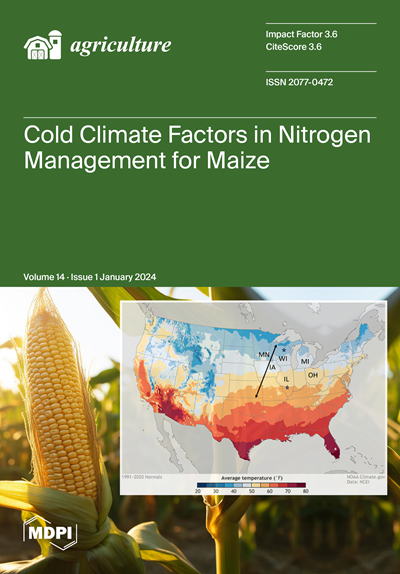依赖砧木的葡萄嫁接中铜的生物积累和转运模式
IF 3.6
2区 农林科学
Q1 AGRONOMY
引用次数: 0
摘要
欧洲葡萄栽培中长期使用铜(Cu)杀菌剂导致了葡萄表层土壤中铜的积累。然而,对于愈伤组织形成后/苗圃种植前葡萄嫁接体内铜的积累情况,我们了解的较少。本文介绍了5BB和SO4砧木积累Cu的能力,以及嫁接中的转运模式。高温胁迫(愈伤组织)后,长相思葡萄嫁接在5BB和SO4砧木上,在温室盆栽中生长6个月,并暴露于不同的铜配方(氯化铜、葡萄糖酸铜)和泥炭浓度(干重50、150、500和1000 mg Cu)中。除了监测植株生长动态和分析移植器官中铜的含量外,还计算了铜的生物积累(baf)和转运因子(TFs)。根(15 ~ 164)>砧木干(8 ~ 38)>藤(5 ~ 21)mg kg−1 DW。铜的浓度取决于铜的配方和底物中的浓度。两种砧木(5BB和SO4, 23-155和15-164 mg kg - 1 DW)的根部铜含量均较高,而在氯化铜处理过的泥炭中嫁接的茎部铜含量最低(低于10 mg kg - 1 DW)。基于BAFs和TFs,这两种砧木可以被认为是不含Cu的。系统葡萄糖酸铜和SO4砧木的易位率较高。尽管铜对葡萄嫁接生长的抑制作用在生长的前两个月明显表达,但通过对茎长的测量,还不能证实铜对葡萄嫁接生长的显著抑制作用。含有超过500 mg Cu/kg−1的土壤不太适合种植葡萄嫁接。本文章由计算机程序翻译,如有差异,请以英文原文为准。
Patterns of Copper Bioaccumulation and Translocation in Grapevine Grafts Depending on Rootstocks
The long-term use of copper (Cu) fungicides in viticulture in Europe has led to Cu accumulation in vineyard top soils. However, less is known about the accumulation of Cu in grapevine grafts after the callusing process/before planting in the nursery. This paper presents the capacity of 5BB and SO4 rootstocks to accumulate Cu, as well as the patterns of translocation in the grafts. After heat forcing (callusing), the grapevine grafts of Sauvignon Blanc on 5BB and SO4 rootstocks were grown in pots for six months in a glasshouse and exposed to various Cu formulations (Cu-oxychloride, Cu-gluconate) and concentrations in peat (50, 150, 500, and 1000 mg Cu of dry weight (DW)). In addition to monitoring the shoot growth dynamics and analyzing the copper content in graft organs, bioaccumulation (BAFs) and translocation factors (TFs) of Cu were calculated. The mean Cu concentrations were ranked as follows: roots (15–164) > rootstock trunks (8–38) > canes (5–21) mg kg−1 DW. The Cu concentrations depended on the Cu formulation and concentration in the substrate. Higher Cu content was found in the roots of both rootstocks (5BB and SO4, 23–155 and 15–164 mg kg−1 DW, respectively) and the lowest in the canes (less than 10 mg kg−1 DW) of grafts grown in Cu-oxychloride-treated peat. Based on the BAFs and TFs, both rootstocks could be considered as Cu exclusive. A higher translocation rate was determined in systemic Cu-gluconate and SO4 rootstock. With shoot length measurements, the significant inhibitory effects of Cu on grapevine grafts growth could not be confirmed, despite the inhibitory effects that were clearly expressed in the first two months of growth. Soils containing more than 500 mg Cu/kg−1 are less suitable for growing vine grafts.
求助全文
通过发布文献求助,成功后即可免费获取论文全文。
去求助
来源期刊

Agriculture-Basel
Agricultural and Biological Sciences-Food Science
CiteScore
4.90
自引率
13.90%
发文量
1793
审稿时长
11 weeks
期刊介绍:
Agriculture (ISSN 2077-0472) is an international and cross-disciplinary scholarly and scientific open access journal on the science of cultivating the soil, growing, harvesting crops, and raising livestock. We will aim to look at production, processing, marketing and use of foods, fibers, plants and animals. The journal Agriculturewill publish reviews, regular research papers, communications and short notes, and there is no restriction on the length of the papers. Our aim is to encourage scientists to publish their experimental and theoretical research in as much detail as possible. Full experimental and/or methodical details must be provided for research articles.
 求助内容:
求助内容: 应助结果提醒方式:
应助结果提醒方式:


